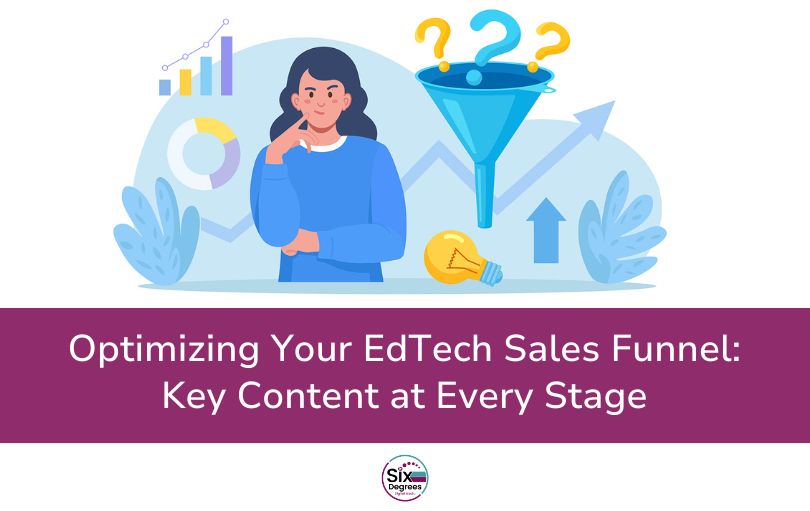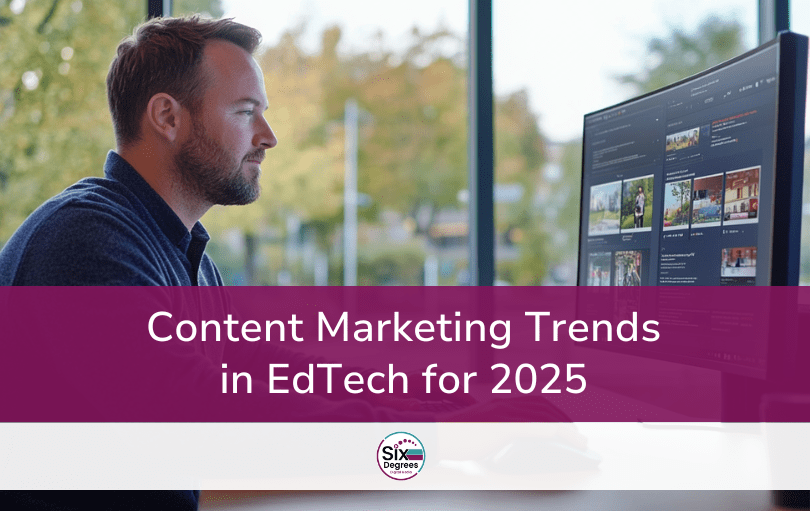$10,000 is a lot to lose– It’s also easy to lose if you’re wasting it on ineffective EdTech marketing campaigns. You may think that the latest strategy is going to do wonders for your business, but in reality, you’re spending way more than necessary for half the results you could have gotten with just a few tweaks.
Successful marketing isn’t just about shouting your message louder; it’s about using data to track and measure what matters. Some data might look good on the surface, like having lots of followers on social media, but they don’t really help your business. Being able to spot these “vanity metrics” can make a big difference.
By understanding different types of data, such as how many people visit your website, what kind of actions they take, and how many interact with you on social media, you can learn a lot about your customers. This can help you make better choices for future campaigns and reach your business goals faster.
So, are you ready to take your EdTech marketing to the next level, tracking the right things, and using data to guide you? It could make a big difference!
Table of Contents:
- Identifying Key Performance Indicators (KPIs) for EdTech Marketing Campaigns
- Analyzing Digital Marketing Data
- Optimizing Digital Marketing Strategies
- Measuring ROI of Digital Marketing Efforts
Identifying Key Performance Indicators (KPIs) for EdTech Marketing Campaigns
When it comes to measuring the success of your EdTech marketing campaigns, understanding which KPIs are most important is crucial. By tracking these metrics, you can gain valuable insights into the effectiveness of your digital marketing campaigns and make informed decisions to optimize future efforts.
Website Traffic Metrics
The first set of KPIs that every EdTech company should track revolves around website traffic. Monitoring overall site visits, unique visitors, and average session duration will give you a clear picture of how many people are engaging with your content and how long they’re staying on your site.
- Total Visits: The number of times users have visited your website during a specific time frame.
- Unique Visitors: The number of individual users who have visited your website during a specific time frame.
- Average Session Duration: The average amount of time users spend on your website per visit.
Conversion Metrics
In addition to monitoring traffic-related KPIs, it’s essential to keep an eye on conversion metrics. These indicators help you understand whether or not visitors are taking desired actions on your site – such as signing up for newsletters or downloading resources – which ultimately contribute to achieving business goals like generating leads or increasing sales revenue.
- Email Signups: The number of new subscribers added through email signup forms over a given period.
- Demo Requests: The total count of demo requests submitted by users on your website in a specific time frame.
- Downloads: The number of times users have downloaded resources, such as whitepapers or case studies, from your website during a specific time frame.
Social Media Metrics
Social media platforms play a significant role in EdTech marketing campaigns, making it essential to track relevant KPIs on these channels as well. By tracking metrics like follower growth and engagement rate, you can assess the success of your social media campaigns and determine areas for optimization.
- Follower Growth: The increase in the number of followers on your social media accounts over time.
- Engagement Rate: A metric that measures how engaged your audience is with your content by considering factors like likes, comments, shares, and clicks. Learn more about calculating engagement rates here.
In addition to these primary KPIs mentioned above, there are many other secondary indicators that may be useful depending on the goals of individual campaigns – such as bounce rate, click-through rate (CTR), cost per acquisition (CPA), etc. It’s important to choose which metrics align best with your objectives so you can focus on tracking and improving them over time to maximize the success of your EdTech marketing campaigns.
Key Takeaway:
Tracking essential metrics such as website visits, conversion data and social media analytics is necessary to assess the effectiveness of EdTech marketing. These KPIs include total visits, unique visitors, email signups, demo requests, follower growth and engagement rate which help in understanding how well digital marketing efforts are performing and making data-driven decisions for future campaigns.
Analyzing Digital Marketing Data
In the world of EdTech marketing, data analysis plays a crucial role in determining the success of your campaigns and identifying areas for improvement. By closely examining the information gathered from various digital channels, you can gain valuable insights into user behavior, preferences, and trends that will help inform future strategies.
To effectively analyze digital marketing data for your EdTech company, consider focusing on these key aspects:
- User Acquisition: Track metrics such as click-through rates (CTR), conversion rates, cost per acquisition (CPA), and organic vs paid traffic to understand how users are finding your platform or product. This information can be used to optimize ad targeting and improve overall campaign performance.
- User Engagement: Monitor engagement metrics like bounce rate, time spent on site, or app usage frequency to gauge how well users are interacting with your content. High levels of engagement indicate that you’re providing value to users while low levels may signal a need for content optimization or better targeting.
- Social Media Performance: Assess social media activity by tracking likes, shares, comments, and follower growth across platforms like Facebook, Twitter, and LinkedIn. These insights can guide decisions about which types of content resonate most with your audience so you can create more targeted posts in the future.
- Email Campaigns: Measure open rates, click-through rates (CTR), and conversions from email campaigns sent out through platforms like Mailchimp or SendGrid. Use this data to refine subject lines, personalize emails, segment audiences more effectively based on their interests/preferences/needs, ultimately leading to higher ROI from email efforts.
It’s essential to utilize the correct instruments for examination with a wealth of data available. Platforms like Google Analytics, KISSmetrics, and Mixpanel offer comprehensive analytics solutions that can help you make sense of your digital marketing performance.
Beyond simply tracking metrics, these platforms also provide valuable insights into user behavior through features such as cohort analysis, funnel visualization, and user segmentation. By leveraging these advanced analytics capabilities, EdTech marketers can better understand their audience and create more effective campaigns tailored to their needs.
Analyzing digital marketing data can help to identify areas of improvement and inform future campaigns. Optimizing digital marketing strategies is the next step in achieving success for EdTech and Higher Education organizations.
Key Takeaway:
Download your free copy of the Ultimate EdTech Digital Marketing Template and build a marketing plan that brings in tons of qualified leads. Get yours here.
Measuring ROI of Digital Marketing Efforts
In order to maximize efficiency and make decisions based on data, it is essential for EdTech marketers to comprehend the ROI of their digital marketing initiatives. This section will explore various methods for measuring ROI in EdTech digital marketing campaigns.
Establishing Clear Goals and Objectives
To accurately measure ROI, it’s essential to first establish clear goals and objectives for your digital marketing campaign. These may include increasing brand awareness, driving website traffic, generating leads, or boosting sales conversions. By defining specific targets tied to these objectives, such as a percentage increase in web traffic or the number of new leads generated per month, you can better assess whether your investments are yielding desired results. You can’t know what you don’t measure.
Tracking Key Performance Indicators (KPIs)
Tracking relevant KPIs is an integral part of measuring success in any digital marketing campaign. Some common KPIs used to determine ROI include cost per lead (CPL), customer acquisition cost (CAC), click-through rate (CTR), and conversion rate among others.
- CPL: Cost Per Lead measures how much it costs your company to acquire a new lead through a particular channel or campaign.
- CAC: Customer Acquisition Cost calculates the average amount spent on acquiring each new customer from all channels combined during a given period.
- CTR: Click-Through Rate indicates the percentage of users who clicked on an ad or link compared to the total number of users who viewed it.
- Conversion Rate: Conversion rate is the percentage of visitors who complete a desired action (e.g., signing up for a newsletter, purchasing a product) on your website or landing page.
Calculating ROI and Adjusting Strategies Accordingly
To calculate the return on investment, one can use a simple formula to determine how successful their marketing investments have been in comparison to industry standards and previous campaigns.
ROI = (Revenue – Cost) / Cost
This will give you an overall percentage that represents how much return your marketing investments have generated. By comparing this figure against industry benchmarks and historical data from previous campaigns, you can determine whether your current strategies are effective or if adjustments need to be made to improve performance.
In addition to calculating overall ROI, it’s also important to analyze individual channels and tactics within your digital marketing mix. This granular approach allows you to identify which specific efforts are driving results and allocate resources more efficiently moving forward (Optimizing Digital Marketing Strategies). Furthermore, regularly reviewing campaign analytics helps ensure that any necessary changes are implemented quickly so as not to waste valuable time and budget on underperforming initiatives.
Key Takeaway:
By calculating overall ROI using the formula (Revenue – Cost) / Cost and analyzing individual channels within your digital marketing mix regularly, you can identify which specific efforts are driving results and allocate resources more efficiently moving forward.
Optimizing Digital Marketing Strategies
In order to achieve the best results in your EdTech marketing campaigns, it’s crucial to optimize digital marketing strategies based on data analysis and KPIs. By continually analyzing performance metrics and adjusting your approach accordingly, you can ensure that your campaigns are as effective as possible.
A/B Testing for Improved Performance
One of the most valuable methods for optimizing digital marketing strategies is A/B testing. This involves creating two or more variations of a specific campaign element (such as an email subject line or landing page design) and comparing their performance against each other. By identifying which version generates better results, you can make informed decisions about how to improve future campaigns.
Personalization for Increased Engagement
To further enhance engagement with your target audience, consider incorporating personalization into your EdTech marketing efforts. Using data collected from user interactions with previous content, you can tailor messaging and offers specifically to individual users’ preferences and needs. For example, segmenting email lists based on demographics or behavior patterns allows you to send targeted messages that resonate with different groups within your audience.
- Data-driven Content Creation: Analyze user engagement metrics such as click-through rates (CTRs), time spent on site, and conversion rates in order to identify topics that resonate well with your audience. Use this information when planning future content creation efforts.
- Social Media Optimization: Monitor social media analytics tools like Facebook Insights or Twitter Analytics to determine which types of posts generate the most engagement and adjust your social media strategy accordingly.
- Conversion Rate Optimization (CRO): Review conversion rates for different campaign elements, such as landing pages or calls-to-action (CTAs), to identify areas where improvements can be made. Implement changes based on these insights to increase overall conversion rates.
Optimizing digital marketing strategies is an ongoing process that requires constant attention and adjustment. Keeping an eye on current trends, examining results data, and utilizing effective tactics in EdTech advertising efforts can help guarantee that your campaigns remain successful.
Maximizing digital advertising tactics can be an effective way to reach the desired demographic and bolster involvement. Leveraging automation tools for efficiency is the next step in taking your EdTech marketing campaigns to the next level.
Key Takeaway:
To achieve the best results in EdTech marketing campaigns, it’s crucial to optimize digital marketing strategies based on data analysis and KPIs. A/B testing is a valuable method for improving performance by comparing different campaign elements, while personalization can enhance engagement with your target audience. Data-driven content creation, social media optimization, and conversion rate optimization are all important practices for ongoing success in edtech marketing.
FAQs for EdTech Marketing Campaigns
How to do marketing for EdTech?
To effectively market an EdTech product, focus on understanding your target audience and their needs. Develop a strong value proposition, create engaging content that showcases the benefits of your product, and leverage multiple digital channels such as social media, email marketing, SEO, and paid advertising. Collaborate with influencers in the education sector and attend industry events to increase brand visibility.
What are the top trends for digital marketing in EdTech sector?
- Personalization: Customizing user experiences based on individual preferences and learning styles.
- Video Marketing: Utilizing video content to engage users through tutorials, webinars or live streams.
- Interactive Content: Creating interactive quizzes or simulations that allow users to actively participate in learning processes.
What is market segmentation?
The market segmentation of EdTech can be divided into four main categories: Pre-K-12, Higher Education, Corporate Training, and Language Learning. These segments cater to different age groups and learning needs, with various products such as Learning Management Systems (LMS), Massive Open Online Courses (MOOCs), e-learning platforms, and educational apps.
Who is your target audience?
The target audience for EdTech includes students at all levels of education (Pre-K-12 and higher education), educators (teachers, professors, trainers), parents seeking supplemental resources for their children’s education, professionals looking to upskill or reskill through corporate training programs or language courses. Additionally, key stakeholders like school administrators or HR managers can also be part of the target audience.
EdTech marketing campaigns require a well-planned strategy that includes identifying key performance indicators, analyzing digital marketing data, optimizing strategies, leveraging automation tools for efficiency and measuring ROI. By focusing on these areas, EdTech businesses can build brand awareness among potential customers in the education sector and increase lead generation.
In conclusion, successful EdTech marketing campaigns involve consistent brand experience across all channels while reaching a wider audience through social media platforms. With relevant keywords and case studies to support educational institutions’ learning opportunities online, EdTech marketers can boost engagement with their target audience and drive sales.
Download your free copy of the Ultimate EdTech Digital Marketing Template and build a marketing plan that brings in tons of qualified leads. Get yours here.






